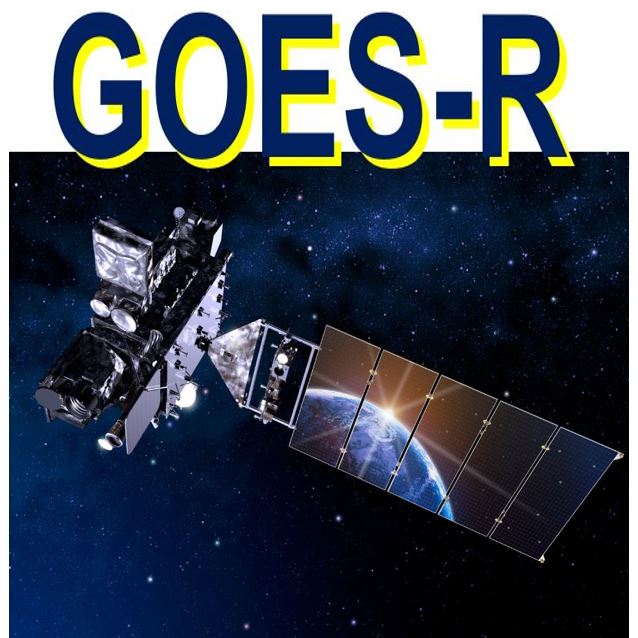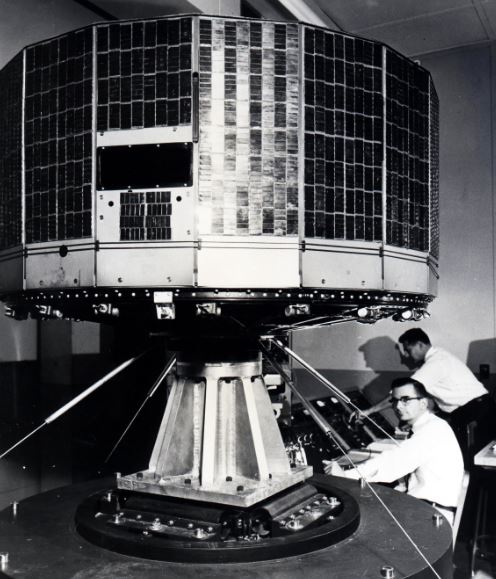GOES-R, a super advanced weather satellite, has been launched by NASA for the NOAA (National Oceanic and Atmospheric Administration). It is the first of a series of highly-advanced geostationary satellites. It will significantly boost the United States’ weather observation network and NOAA’s forecasting accuracy.
GOES stands for Geostationary Operational Environmental Satellite. GOES-R was launched at approximately 23:42 UTC (Coordinated Universal Time) on November 19th from Cape Canaveral Air Force Station, Florida, USA. UTC is the successor to GMT (Greenwich Mean Time).
Accurate forecasts mean timely warnings, which can save lives and protect property.
In two weeks’ time, as soon as GOES-R is in orbit 22,300 miles (35,888 km) above Earth’s surface, it will be called GOES-16. The new state-of-the-art satellite will become operational within twelve months, after it has been thoroughly tested and its six instruments validated.
 An artist’s depiction of GOES-R. The GOES series of satellites will provide significant enhancements for weather forecasters, giving them the ability to observe the whole Western Hemisphere with data available virtually immediately. (Image: nasa.gov)
An artist’s depiction of GOES-R. The GOES series of satellites will provide significant enhancements for weather forecasters, giving them the ability to observe the whole Western Hemisphere with data available virtually immediately. (Image: nasa.gov)
NOAA Administrator, Dr. Kathryn Sullivan, said:
“The next generation of weather satellites is finally here. GOES-R is one of the most sophisticated Earth-observing platforms ever devised. GOES-R’s instruments will be capable of scanning the planet five times faster and with four times more resolution than any other satellite in our fleet.”
“With these new instruments and powerful new capabilities, GOES-R will strengthen NOAA’s ability to issue life-saving forecasts and warnings and make the United States an even stronger, more resilient Weather-Ready Nation.”
GOES-R is faster and sharper
GOES-R will be able to scan the skies five times faster than current GOES spacecraft, with three times the spectral channels and four times greater image resolution.
The satellite will provide rapid-refresh, high-resolution satellite imagery up to once every thirty seconds. This means scientists can gather and analyze considerably more data about, for example a storm, to determine whether it is decaying or gaining in size and strength.
 The United Launch Alliance Atlas V first stage. GOES-R was launched atop the Atlas V rocket on November 19th. (Image: nasa.gov. Credits: NASA/Kim Shiflett)
The United Launch Alliance Atlas V first stage. GOES-R was launched atop the Atlas V rocket on November 19th. (Image: nasa.gov. Credits: NASA/Kim Shiflett)
Thanks to GOES-R data, hurricane tracking and intensity forecasts will improve considerably, as will the prediction and warnings of severe weather events, including thunderstorms and tornadoes.
The satellite’s superior rainfall estimates will lead to more accurate and timely flood warnings.
NOAA National Weather Service Director, Dr. Louis W. Uccellini, said:
“We are ready to receive and process GOES-R data into our forecasts as soon as it is available.”
“Forecasters will not only have sharper, more detailed views of evolving weather systems, they will have more data – better data – ingested into our weather models to help us predict the weather tomorrow, this weekend and next week. This is a major advancement for weather forecasting.”
GOES-R helping aviation sector
For the aeronautics sector, GOES-R will deliver clearer views of clouds at varying atmospheric levels, generating more accurate estimates of wind direction and speed, as well as improved detection of ice, lightning and fog.
This will make it easier for aircraft to avoid turbulence and other hazardous conditions.
 GOES-R begins its voyage into space aboard the Atlas V rocket. (Image: noaa.gov)
GOES-R begins its voyage into space aboard the Atlas V rocket. (Image: noaa.gov)
Craig Fugate, FEMA (Federal Emergency Management Agency) administrator, said:
“GOES-R will significantly improve the ability of emergency managers across America to prepare for, and respond to, weather-related disasters. Better situational awareness will result in better outcomes — from where to best position resources ahead of a storm to delivering more targeted information to local officials to decide if an evacuation is necessary.”
GOES-R has six new instruments, including the first ever operational lightning mapper in geostationary orbit. With this new technology, scientists will be able to observe lightning, a major indicator of where and when a storm is likely to strengthen.
Forecasters will be able to use the mapper to hone in on the most hazardous storms. Advanced space weather sensors on the satellite will monitor the Sun and relay crucial data to forecasters, who can then issue weather warnings or alerts.
GOES-R will provide data that will result in thirty-four improved or new meteorological, space and solar weather products.
 Engineers performing pre-flight vibration testing on TIROS 1, America’s first weather satellite. It was launched in 1960. TIROS stands for Television InfraRed Observational Satellite. (Image: nasa.gov)
Engineers performing pre-flight vibration testing on TIROS 1, America’s first weather satellite. It was launched in 1960. TIROS stands for Television InfraRed Observational Satellite. (Image: nasa.gov)
A historic performance milestone
Dr. Stephen Volz, Director of NOAA’s Satellite and Information Service, said:
“We’ve crossed an historic performance threshold with GOES-R. NOAA is now operating the most sophisticated technology ever flown in space to help forecast weather on Earth.”
The whole series consists of four satellites: GOES-R, -S, -T and –U. It will extend NOAA’s geostationary coverage for the next two decades.
Sandra Smalley, director of NASA’s Joint Agency Satellite Division, which collaborated with NOAA to manage the development and launch of GOES-R, said:
“NOAA and NASA have partnered for decades on successful environmental satellite missions. Today’s launch continues that partnership and provides the basis for future collaboration in developing advanced weather satellites.”
GOES-R will be part of SARSAT (Search And Rescue Satellite Aided Tracking), a multinational satellite-based search & rescue network. The satellite’s special transponder is able to detect distress signals from emergency beacons.
Ironically, GOES-R faced some extreme weather on October 6 and 7. The east coast of Florida, including Kennedy, was struck by Hurricane Matthew. All hands had to work at lightning speed to protect the satellite from possible damage.
Diana Calero, NASA GOES-R mission manager in LSP (Launch Services Program) said:
“It’s interesting that a satellite that’s supposed to be out hunting hurricanes was affected by a hurricane and caused a delay to its launch.”
“For the spacecraft, they had a metal structure that was built around the spacecraft. Then it was covered in a plastic-like material all the way around to protect GOES-R in the event of falling debris.”
Video – GOES-R will revolutionize weather forecasting
GOES-R is a new tool that will revolutionize weather forecasting, says NASA in this video. This is the first in a series of next-generation Geostationary Operational Environmental Satellites (GOES) for NOAA.
